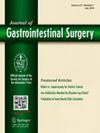Patients with class III obesity are at elevated risk of postoperative morbidity after surgery for left-sided diverticular disease: a retrospective population-level study
IF 2.2
3区 医学
Q3 GASTROENTEROLOGY & HEPATOLOGY
引用次数: 0
Abstract
Background
Although obesity is a well-established risk factor for the development of diverticular disease, studies focusing on the effect of body mass index (BMI) on postoperative outcomes require updating. This population-level retrospective cohort study was designed to evaluate the effect of BMI on postoperative outcomes after operative intervention for left-sided diverticular disease.
Methods
This was a population-based retrospective cohort study using the Healthcare Cost and Utilization Project National Inpatient Sample (NIS) (September 1, 2015 to December 31, 2019). The International Classification of Diseases, 10th Revision, Clinical Modification codes were used to identify a cohort of adult patients with a primary admission diagnosis of diverticulitis. Patients were stratified according to obesity status (ie, not obese: BMI of <30.0 kg/m2; class I obesity: BMI of 30.0–34.9 kg/m2; class II obesity: BMI of 35.0–39.9 kg/m2; class III obesity: BMI of >40.0 kg/m2). The primary outcome was overall in-hospital postoperative morbidity. The multivariate regression models were fit.
Results
There were 33,029 patients identified in the NIS who underwent left-sided colonic resection for diverticular disease. There were 27,212 patients who were not obese, 2209 patients with class I obesity, 1710 patients with class II obesity, and 1898 patients with class III obesity. Patients with class III obesity (ie, a BMI of >40.0 kg/m2) had 72.7% higher odds (95% CI, 1.54–1.94) of experiencing in-hospital postoperative morbidity than patients with a BMI of <30.0 kg/m2. Patients with class III obesity had 26.9% higher odds (95% CI, 0.98–1.65) of experiencing in-hospital postoperative infection, 54.6% higher odds (95% CI, 1.35–1.77) of experiencing in-hospital postoperative gastrointestinal complications, and 70.9% higher odds (95% CI, 1.48–1.97) of experiencing in-hospital postoperative genitourinary complications than those with a BMI of <30.0 kg/m2.
Conclusion
Patients with class III obesity undergoing operative intervention for colonic diverticular disease are at increased risk of short-term postoperative morbidity compared with those with a BMI of <30.0 kg/m2.

III 级肥胖症患者在左侧憩室疾病手术后发病风险较高:回顾性人群研究
背景:虽然肥胖是憩室疾病发病的一个公认风险因素,但有关体重指数(BMI)对术后效果影响的研究需要更新。我们设计了这项人群水平的回顾性队列研究,以评估左侧憩室疾病手术干预后体重指数对术后效果的影响:这是一项基于人群的回顾性队列研究,使用的是医疗成本与利用项目全国住院患者样本(NIS)(2015 年 9 月 1 日至 2019 年 12 月 31 日)。研究利用 ICD-10-CM 编码确定了一批主要入院诊断为憩室炎的成年患者。根据肥胖状态对患者进行分层(即非肥胖:即非肥胖:体重指数低于 30kg/m2;I 级肥胖:BMI 30-34.9kg/m2;II 级肥胖:BMI:35-39.9kg/m2;III 级肥胖:BMI大于40kg/m2)。主要结果是总体院内术后发病率。采用多变量回归模型进行拟合:结果:NIS共识别出33029名因憩室疾病接受左侧结肠切除术的患者。其中非肥胖患者 27212 人,I 级肥胖患者 2209 人,II 级肥胖患者 1710 人,III 级肥胖患者 1898 人。与体重指数小于 30 的患者相比,III 级肥胖患者(即体重指数大于 40)的院内术后发病率高出 72.7% (95% CI 1.54-1.94)。与 BMI 小于 30 的患者相比,III 级肥胖患者发生院内术后感染的几率要高 26.9%(95%CI 0.98-1.65),发生院内术后胃肠道并发症的几率要高 54.6%(95%CI 1.35-1.77),发生院内术后泌尿生殖系统并发症的几率要高 70.9%(95%CI 1.48-1.97):结论:与体重指数低于 30 的患者相比,接受结肠憩室疾病手术干预的 III 级肥胖患者术后短期发病风险更高。
本文章由计算机程序翻译,如有差异,请以英文原文为准。
求助全文
约1分钟内获得全文
求助全文
来源期刊
CiteScore
5.50
自引率
3.10%
发文量
319
审稿时长
2 months
期刊介绍:
The Journal of Gastrointestinal Surgery is a scholarly, peer-reviewed journal that updates the surgeon on the latest developments in gastrointestinal surgery. The journal includes original articles on surgery of the digestive tract; gastrointestinal images; "How I Do It" articles, subject reviews, book reports, editorial columns, the SSAT Presidential Address, articles by a guest orator, symposia, letters, results of conferences and more. This is the official publication of the Society for Surgery of the Alimentary Tract. The journal functions as an outstanding forum for continuing education in surgery and diseases of the gastrointestinal tract.

 求助内容:
求助内容: 应助结果提醒方式:
应助结果提醒方式:


